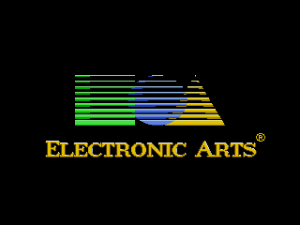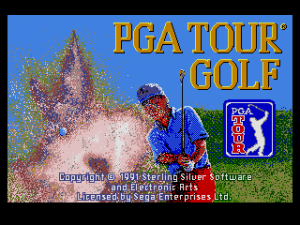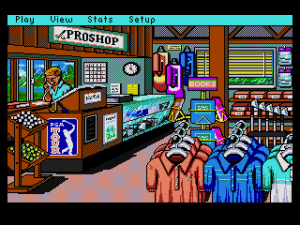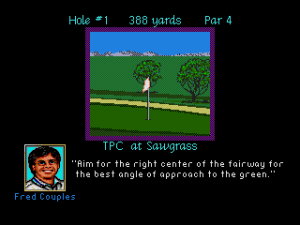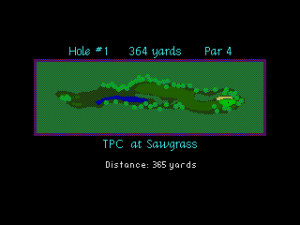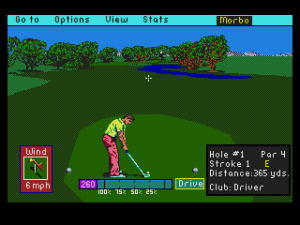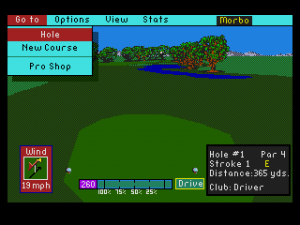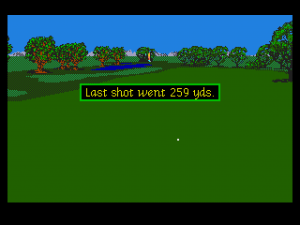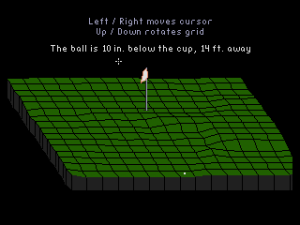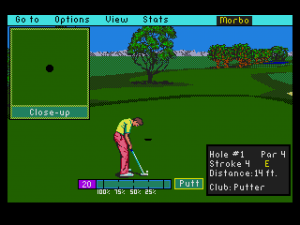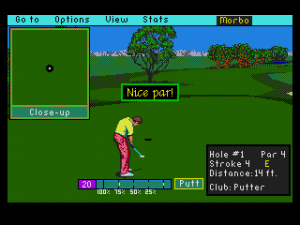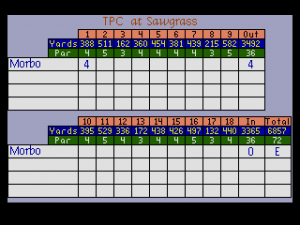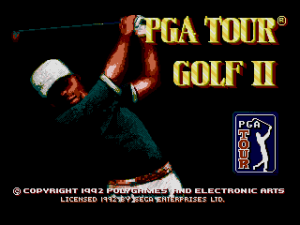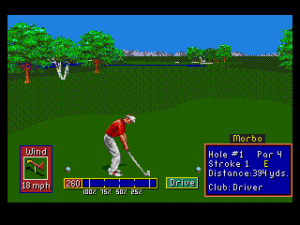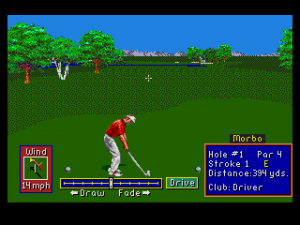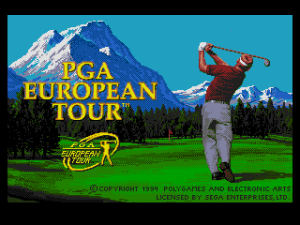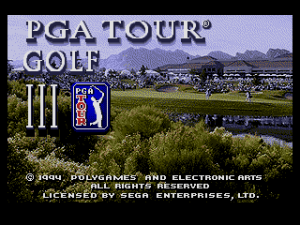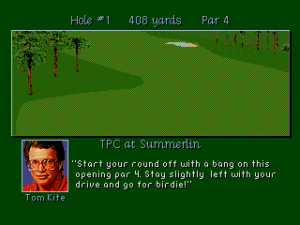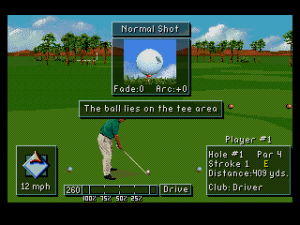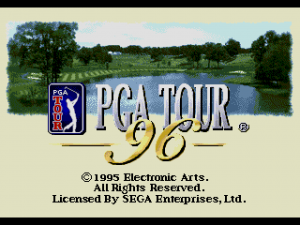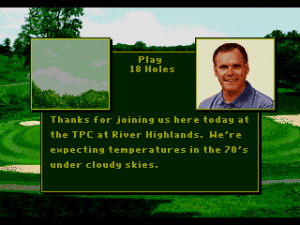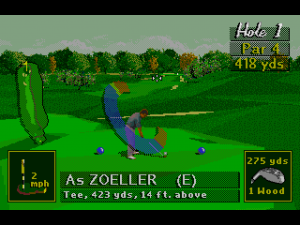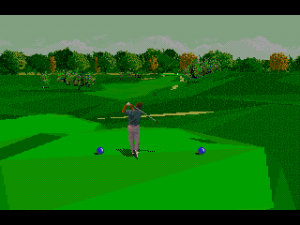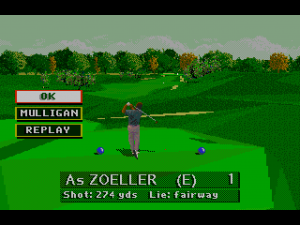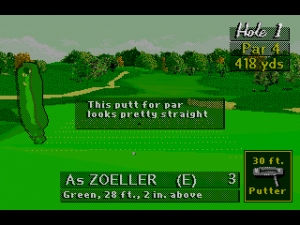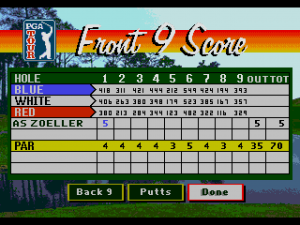To continue my review of golf games for this console, I shall talk about five games in the same series – “PGA Tour Golf”.
That box is for the first one of these that I played, and in my opinion the best of them all. It’s also what I consider the finest golf video game ever made. But who knows, I may find a better one while I’m doing these reviews.
In 1991 came “PGA Tour Golf”, which sets the standard for most of the series. Note the appearance of the old style EA logo above. I have a theory that they stopped caring about releasing quality games around the time they stopped using that logo.
But anyway, the menu screen you see when you begin looks like this:
There is no jumpy, bouncy music here, and no razzle-dazzle animation to try and get your attention. This game knows that it’s a golf game, and it knows what that means. There is music elsewhere in the game, and it sounds appropriate for the game (as far as you would expect to hear on a Genesis).
From this screen, you can set up options and load a previously saved game. The C button shows and hides the menu, the A button selects the highlighted items. There are several professional golfers that appear throughout the game, though you can not actually play as their pre-made characters in this game. Options available to you include club selection, pro or amateur tees and two styles of play – practice or tournament.
As you get started on your first hole in one of four courses, you get to see a flyby of the hole. And this is the best I’ve seen so far for these games I’ve reviewed.
You will also automatically be shown a top-down view of the hole and a popup window of your ball lie before every shot. You can disable these auto-views in the menu, and you can go back to them at any time from that same menu.
There is also a wind meter, and wind plays an important part in this game. On the bottom right of the screen you can see more information about the hole and your current situation. Up and down on the gamepad will switch clubs, left and right will aim. C brings up the menu, A shows you the ball lie and B is the action button. The start button brings you back to the main menu screen.
Your caddy will automatically choose the appropriate club for you, and usually the choice is the best. This game has a “special shots” option that can be used to alter the way you make your shot. You can switch to and from a punch shot, chip shot, or fringe putt if you feel the situation calls for it.
To make your swing, press B. The power meter is 3-button press type. If you make a really nice shot, you will see an instant replay, but you can also see a replay of any shot by going into the menu and choosing “Instant Replay” from the “Options” menu.
Making it onto the putting green brings up the very best and easiest to read terrain grid I have seen for a golf game so far:
You can rotate the view by pressing up or down on the gamepad, and you can adjust your aim from this screen by pressing left or right. I have made some extremely long putts by following the contours of the green and compensating for the slope with my aim before.
The power meter requires one button-press less when you putt, and wind is no longer a factor. Also, pressing up and down on the gamepad when you put will change the strength of the putt.
And that’s it for the first game in the series. Already, there is a lot in place to make this game a strong contender for one of the best golf video games ever. The sounds are highly realistic and not goofy. The whole “feel” of the game is that it’s finely crafted too, and nothing feels like it’s broken or even a little bit off.
1992 saw the release of “PGA Tour Golf II”.
Although the game looks very similar to the previous version, it apparently has a new graphics engine. All of the same gameplay is there, and there has been some refinement and improvement to the physics.
To view the menu, press Start. Pressing C will now bring up the draw & fade meter shown above. You can use this to help refine your swing and get around obstacles like trees, sand and water.
Other improvements include added modes of gameplay. You can choose between practice round, tournament, skins challenge, driving range, and putting green. There are also seven different courses to choose from.
Professional golfers also make an appearance in this game, though you still can not play as them – only against them in the tournament.
The next game to be released in the series was “PGA European Tour”, and it came out in 1994.
It was an expansion release of “PGA Tour Golf II”, with nearly identical gameplay. The only differences are that it features European pro golfers and 5 European courses. There are also more modes of gameplay, and you can choose from practice round, tournament, skins challenge, match play, shoot-out, driving range, and putting green.
Along with the flyby for each hole, you get a weather report, but this is kind of superfluous because the wind meter still gives you the best information about that. Another addition is the ability to jump to a different course right from the menu while you’re still playing.
Taking into consideration everything I’ve said about the series above, I consider this to be the pinnacle of not just these five games, but of all golf video games I’ve ever played. The sounds are realistic, there are no annoying aspects to it, and it is challenging enough to keep me returning to it time and time again.
Also released in 1994 was “PGA Tour Golf III”.
Note the use of the modern EA logo. If my theory is correct, we’re about to see a dip in quality.
This game features a revamped interface and slightly altered gameplay. And I think the game suffers for it. The designers were going for a more toned-down look with less sharp-contrasted colours than previous versions:
I think it makes the game and the interface look kind of dull. It actually gets to be a bit of a strain on the eyes when everything is in shades of dark green and earth tones.
The biggest change to the gameplay is the addition of a new aiming/ball-strike window that appears before every swing:
You can switch the type of shot you make (normal, punch, chip) by pressing B. There is a flashing cross that appears on the ball in the center, and you can use the direction pad to move it up, down, left and right. This will determine the contact point where your club strikes the ball. Press C to confirm and continue.
Pressing A will show you the top-down view of your hole:
While you’re in the game, pressing the start button will bring up a vastly simplified menu:
And pressing C will return you to the new aiming/ball-strike window. The draw/fade meter that was introduced with “PGA Tour Golf II” is gone.
Gameplay for this third installment seems a little slower to me for some reason. Other than that, there aren’t any other differences that I could see from the other games in the series that came before it. It’s a very good golf game, but my personal opinion is that the changes that were made to the interface were not necessary and diminished the quality of what was an outstanding and perfect game.
Last in this series came “PGA Tour ’96” in 1995.
This game is a complete redesign in 3D.
Sigh.
Well, it’s not bad. But it’s definitely not as good, and in my opinion not as fun as any of the games that came before it. The controls are basically the same. But this time you can play as one of the pro golfers included:
There’s no flyby, but you do get a tidbit of info about the weather. And you get thanked for showing up.
The view of the course takes a long time to render. Seeing as how this came out in 1995, 3D rendering and pre-rendered 3D images on 16-bit consoles were all the rage. This game makes an attempt to provide the most realistic look of a golfer on a golf course possible:
I would point out that we’re still playing a Sega Genesis here, and that it’s still nice to be able to see all of the information and controls we need to see clearly at a glance. Plus, I don’t like waiting as long as this game takes for everything to render. Seriously, it’s longer than the Commodore 64 takes to render “Leaderboard Golf”.
With the attempted realism and blending of shades and colours comes a loss of definition I think, and the scenery kind of looks a bit like a jumbled mess. I had an easier time seeing what was going on in the first three games of this series.
This game also introduces to these reviews something that I don’t particularly like in golf video games: the “mulligan”.
If you fucked up that shot, you can just do it again and the messed up shot won’t count on your score. What’s the point of playing then?
When you get to the putting green, you see a differently rendered terrain grid and a short summary about the slope:
This isn’t nearly as effective for me as the way this was handled in the first three games. To make things worse, the power meter on the putting green decides to become the embodiment of Satan himself. If you end your shot too early, even by one pixel, you will hook the shot badly to the left. If you end your shot too late, you will slice it badly to the right. Where did the sudden horrible increase in difficulty level come from? The rest of the course isn’t like this at all, and the power meter reacts pretty much like it does in the other games in the series.
And lastly, I have to come down hard on the music for this one. Thankfully there is no music during the actual game, but the music they chose for the cut scenes and setup menus is fucking terrible. It’s smooth jazz elevator music from hell featuring Kenny G on haunted evil Sega synth sax.
There were no more Sega Genesis PGA golf games after this. I don’t know if that is because it was just the end of the console’s life cycle or because this game was such a regression that it didn’t sell many copies. I’d like to think it was the latter if there is any justice in this world.
But other than the last game and aspects of the fourth, this series is incredible. “PGA European Tour” in particular is an amazing game to play, and you simply must find a way to experience it if you like playing golf video games. If you don’t have the original hardware, I recommend the Kega Fusion emulator to play these games on your PC.
It may seem like there’s not much to these games, or that a 16-bit system couldn’t possibly provide such a deep and enthralling experience. But these games get all of the basics so bang-on perfect that they make video game golf addicting.

